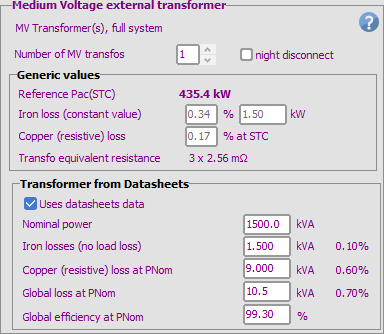External transformer losses
Defining external transformers
In many large PV installations (in the MWp range), the transformer is not part of the inverter, but an external device directly connected to the MV or even the HV grid.
In the Detailed losses => Ohmic losses dialog, you have the possibility to define the following configurations:
- One or several Medium Voltage transformers for the whole system. PVsyst will distribute equally the power output of all inverters to all transformers.
- One Medium Voltage transformer in each sub-array. The transformer properties may be different in different sub-arrays, but each sub-array has to have one transformer.
- There is the possibility to add a High Voltage transformer that steps up the voltage before the injection point.
Transformer definition
The main losses associated with a transformer are:
- The iron losses, which are mostly due to hysteresis and eddy currents in the transformer core, are proportional to the square of the core flux, i.e. to the square of the voltage. Since the grid voltage is constant, this will also be a constant loss. As default value, PVsyst will use 0.1% of the reference nominal power.
- Night disconnect: The iron loss remains active and constant as long as the transformer is connected to the grid, and this may represent a significant energy loss. In the simulation results, this will show up as negative a E_Grid system yield during the night. It may be economically profitable to foresee a switch that disconnects the transformer from the grid during the night. To activate this behavior in the simulation, please check the option "Night disconnect" next to the number of transformers. This option is global for all transformers in the system.
- The ohmic losses, also named copper losses, are originated by the resistance of the primary and the secondary windings of the transformer coils. These may be represented by a single equivalent resistance R, and in the simulation this loss will be computed as R * I² . Like for the cable losses, this means that the relative loss is proportional to the current (or power).
Generic values
Similar to the approach in the cable losses, PVsyst proposes a generic Ohmic loss initial relative value, for the early stage of the project's development.
This is defined as a percentage loss with respect to the reference nominal power, i.e. either PNomPV(ac) or PNom(Inv).
Datasheets definition
You can also define the real parameters of the chosen transformer (recommended).
The main information required is the Nominal power, the Iron loss (often named "no load loss") and the Copper loss.
The datasheets may specify either the global loss at PNom, or the global efficiency, from which PVsyst will deduce the copper loss.
Defining the real parameters from the Transformer's datasheet will fix the Generic values. NB: The generic Iron and Copper losses for the simulation are not identical to the values of the transformer datasheets, as they are related to the Reference PNom of PVsyst instead of the Nominal power of the transformer.
Relationship between the Generic and Datasheets values
Determination of the parameters using Transfo's specified parameters at PnomTrf
The transformer manufacturer may specify, either in terms of power:
| a nominal power | PNomTrf |
| a global loss under this nominal power | PGlobLossTrf [kW] |
| an iron loss under no load | PIronLssTrf [kW] |
| => the resistive power loss is | PResLssTrf = (PGlobLossTrf - PIronLssTrf) [kW] |
or alternatively in terms of loss factor at PNom:
| a global loss factor under PNom | FGlobLossTrf [%] = 100 * PGlobLossTrf / PNomTrf |
| an iron loss factor under no load | FIronLssTrf [%] . = 100 * PIronLssTrf / PNomTrf |
| a resistive loss factor | FResLssTrf [%] . = 100 * PResLssTrf / PNomTrf |
We can deduce the Transformer resistance (which is the basic parameter during the simulation):
| Nominal current at nominal power | INomTrf = PNomTrf / (UNom * Sqrt(3)) |
| => Transformer equivalent resistance | ResTrf = PResLssTrf / INomTrf ² (for one wire) |
Remember that the resistive power loss goes with the square of the current, i.e. the Operating power Poper.
Passing to the PVsyst parameters, referenced to PnomAC
In PVsyst the transformer losses are specified as percentages of the reference nominal power (either PNomPV(ac) or PNom(Inv)).
NB: this PNom_Ref. is a definition for the calculations. This should be considered as not affected by the inverter or grid injection limitations.
- PIronLss(PVsyst) = PIronLssTrf [kW] (doesn't depend on PNom)
- FIronLss(PVsyst) = PIronLssTrf [kW] / PNom_Ref = FIronLssTrf * PNomTrf / PNom_Ref
- PResLss(PVsyst) = PResLssTrf * PNom_Ref ² / PNomTrf ²
- FResLss(PVsyst) = PResLss(PVsyst) / PNom_Ref = FResLssTrf * PNom_Ref / PNomTr,
i.e. the opposite behaviour as the Iron losses (the higher thePNom_Ref, the higher the resistive loss factor).
As an example
Transformer parameters from the datasheets:
- PNomTrf = 1.5 MW
- PIronLssTrf = 1,5 kW (i.e. 0.1% of PNomTrf)
- PGloblossTrf = 16.5 kW (under nominal power PnomTrf)
=> The resistive loss is PGloblossTrf - PIronLssTrf = 15 kW (i.e. 1.5% of PnomTrf).
In PVsyst, if we choose PNom_Ref = PNomPV(ac), and if we have a PV system of 1.05 MWp with an inverter efficiency = 95% @PNom
=> PnomPV(ac) = 1 MW (the PNomPV(ac) value appears as "Pac" on the AC circuit loss dialog).
Applying the previous expressions:
- PIronLss(PVsyst) = 1.5 kW
- FIronLss(PVsyst) = 1.5 kW / 1 MW = 0.15%
- PResLss(PVsyst) = 15 kW * (1 MW / 1.5 MW)² = 15 kW * 0.444 = 6.66 kW
- FResLss(PVsyst) = 6.66 kW / 1 MW = 0.66%
The values 0.15% and 0.66% are those to be introduced as generic values in PVsyst.
